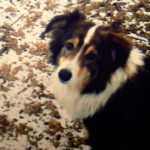(Updated March 2006)
Warsaw: Rebirth, Memorials and Paradise
Warsaw is one of the great phoenix cites of the world, having risen from the ashes and slaughter of two horrific teutonic wars followed by a Russian takeover in 1945. 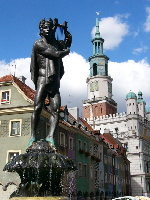 Now, fifteen years after the 1989 demise of the communist offenses Warsaw has again rebuilt itself into a livable, bustling, efficient megopolis with trams and buses running along wide avenues lined with countless mom-and-pop shops as well as magastores and malls.
Now, fifteen years after the 1989 demise of the communist offenses Warsaw has again rebuilt itself into a livable, bustling, efficient megopolis with trams and buses running along wide avenues lined with countless mom-and-pop shops as well as magastores and malls.
The painstaking restoration of the bombed and burned old town is a miracle of design and craftsmanship. What was once post-war piles of rubble is today a charming old world enclave of decorative burgher houses and cobblestone alleyways full of florist shops, outdoor cafes, artists’ exhibits, souvenir shops, picturesque restaurants and proud Poles with a vital identity and economy strong enough to join the EU in May 2004.
And of course, there are numerous memorials to the war dead throughout the city. The past is gone but not forgotten here. The huge sculptural monuments are visceral and dramatic; they are virtually alive with larger-than-life figures of people struggling or suffering.
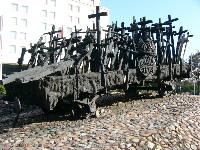
Bronze sculpture of a railroad car full of crosses symbolizing the loss of Polish citizens deported by the Soviets to Siberia.
Every day busloads of students and tourist unload at these memorials to learn or be reminded of the not-so-distant 20th century past. Poland’s history is full of invasion and suffering. But it’s also a much changed place.
And with those changes has been the gradual rise of gay life in Warsaw, another sort of phoenix emerging from the gray oppression of past communism and ever-present Catholicism. But this rise has been much less visible and vigorous than the remaking of architecture. Communism may be gone but the church is still a force to be reckoned with.
Poland is the most politically Catholic country in Europe; churches are the symbolic core of the smallest villages across the fertile rural landscape, even though most people don’t attend mass regularly; big city cathedrals drip with baroque and rococo adornments, statuary, frescos and centuries old obeisance to the Pope, who happens at this time (Sept 2004) to be a Pole from Krakow.
Paradise
Given the dense air of sanctimony in Poland’s culture it’s perhaps no small irony that one of Warsaw’s biggest and loudest gay disco/bars is called Paradise. By way of the cross or by way of the grape vine Paradise is not easy to find. The club is tucked well away from the main road in a commercial warehouse-sized building on Wawelski Street. You cannot stumble upon Paradise by accident—it has to be desired.
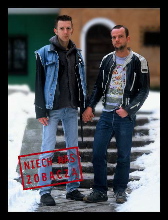
Anti-homophobia Poster boys (KPH)
But once inside (weekend cover change is $2) this bland unappealing structure is transformed into a monumental sound and light palace packed with hundreds of Warsaw’s lesbigay youth gyrating to a deafening beat of dance music. The main dance floor was not jammed (it was only 11:30 PM) but still held plenty of mostly-guys dancing in singles or pairs. Leading them on pedestals were two go-go boys—fully clothed–leading the rhythm. Surprisingly, no one had his shirt off as they worked up a sweat.
As I wandered across the dance floor to another room the base beat was so loud I felt as if my chest was being defibrillated. Never mind the effect on my auditory nerves. But for the young crowd the mood was upbeat. Some people were taking a break from dancing in a sizeable lounge room with lots of sofas and cocktail tables. Dozens of guys and some girls smoked, drank and tried to talk over the music. Two bars served mostly beer. Hard liquor here, like hard drugs, are usually too expensive for the meager budget of most Polish youth. Past the lounge was a karoke room where another several dozen guys and some girls were having a silly laughing time belting out Polish lyrics read from the TV monitors.
This was the only area where I cold hear voices, granted they were amplified along with the music. Conversation was only possible outside on the patio area where a few friends chatted in the refreshingly cool September night air. I was glad to breath it again as I emerged from my visit to this very vibrant hall.
The smoky air and intense light and noise inside may have been toxic for me but I was very glad to see what was happening here. Such a place was impossible under communism and even now in the face of high religious and social homophobia in Poland, Paradise is well named for the freedom of expression, however restrained, it offers to the new generation of Polish gay youth.
Dinner with Edward and Edward
There are other discos and dance bars in Warsaw, of course, but not all—probably most—gay and lesbian Varsovians (Warsaw residents) go to such wild and thunderous venues. These are the ‘mature’ folks who grew up and came out secretly during the communist years. The closets were very full then and even today most middle-aged or senior lesbigays do no allow their sexual identities to be known in public.
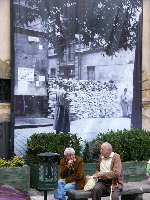 Edward M. and Edward E. (not pictured) live in central Warsaw near busy Constitution Plaza with its trams, cafes, boutique shops, a fire station, police station and ATM bankomat. Both men are in their sixties but still retain handsome appearances. An easy walk brings them to the green grocer, the butcher, a Catholic church (which they don’t use) and to one of the city’s dozen gay venues called ‘LD’, a small cozy bar with baroque sconce lights and hand-painted frescos on the walls and ceilings.
Edward M. and Edward E. (not pictured) live in central Warsaw near busy Constitution Plaza with its trams, cafes, boutique shops, a fire station, police station and ATM bankomat. Both men are in their sixties but still retain handsome appearances. An easy walk brings them to the green grocer, the butcher, a Catholic church (which they don’t use) and to one of the city’s dozen gay venues called ‘LD’, a small cozy bar with baroque sconce lights and hand-painted frescos on the walls and ceilings.
The evening started with a light meal with the two Edwards at their two-bedroom fourth-floor flat in a modern apartment block. They bought their place about sevenyears ago and today’s value would be about $85,000. (Other similar-size but more upscale new flats in the area are going for well over $250,000.). Their home is modestly furnished with some antique pieces and old Persian carpets, a modern kitchen.
Each has an office in one of the bedrooms and both are connected to the Internet. Our comfortable conversation ranged from elder-care (one of their mothers just died at 97), to socialized medicine (Edward E. is a physician; he was paid $15 a month under communist rule), to gay activism and gay marriage They have been a couple for 31 years and have never imagined being married.
Two often-heard generalizations about gay Poland is that ‘ homophobia is rampant’ in this ‘most Catholic country in Europe’. The Edwards dismissed both of these rumors with a shake of the head. “Yes, the church here once had much influence but now that is just a superficial idea. Most people do not go to church and do not listen to what priests say. Their power is only symbolic not real. People think for themselves and are more attending to their work and families,” said Edward M. who recently retired as a radio journalist for many years.
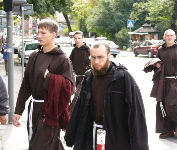
Monks in downtown Krakow
Doctor Edward added with a scornful tone, “besides there are so many gay people in the clergy here they know better than to try and express anti-gay attitudes. Their response to gay life is silence. It’s the right wing Catholics in the Parliament and their followers who make homophobia an issue.”
As well, there was a recent church scandal in Poznan where an archbishop was forced to resign because of his inappropriate behavior with young men.
But the conservatives only represent one segment of the population. According to both Edwards Poland is a liberal-minded culture that has always accepted different ideas and customs. “We don’t have the ethnic prejudice here that some countries like Germany and France have. We welcome immigrants. So Warsaw is open to gays I think, except for the right wing.” But social changes must come slowly they thought. The presence of a gay parade, for many, is seen as a ‘crazy or ‘weird’ sight and not as a serious political statement. Even many non-gays who support gay rights think it is too much of a strain to see costumed and bare-chested gays in the streets blowing kisses and waving rainbow flags.
I suggested that fifteen years (since 1989) is not so slow for a gay parade to come about and both of our hosts acknowledged that in the past three years there has been more gay pressure to speak out and be seen, although the idea of gay marriage in Poland is a long way off.
They both went on to say that in their work and as a couple they have never experienced any discrimination or interference personally or indirectly. “I’m sure there are some of my colleagues know I am gay,” said doctor Andrzej, “but this is not something they would ever mention. We are professional persons working to train young doctors. That is my value, not who I live with.” Journalist Edward added, “our neighbors know that we are two men living together. Its obvious we are gay but we are friendly with all of them. We also have several other gay neighbors here.”
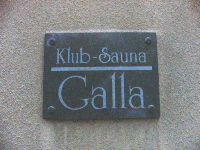 As a palpable test to this proclaimed tolerance and laissez-faire attitudes in central Warsaw today, there is a well-known gay sauna (sex club) on the ground floor of the same apartment block that houses the predominantly heterosexual neighbors of the Edwards.
As a palpable test to this proclaimed tolerance and laissez-faire attitudes in central Warsaw today, there is a well-known gay sauna (sex club) on the ground floor of the same apartment block that houses the predominantly heterosexual neighbors of the Edwards.
From the street Klub Sauna Galla looks subdued, trendy and modern like any other boutique shop. There’s even an aquarium in the front window with fish slowly drifting around as if to suggest the easy comfort within the portal.
Said doctor Edward, “you see it’s really about business. People will open a business if they think they can make money and no one can blame them. We have a friend who opened a gay bar almost next to a police station near here!”
On the Town
The comfortable ambience of the evening was a bit disarming. These two senior professional long-term lovers framed their gay lives with discretion, well away from the front line of gay visibility. Their homophobia-free lives are not unusual for men of their age whose feelings, romance and sexual behavior were forced underground by harsh church and state penalties for most of the 20th century.
Fortunately they found each other while in their thirties and developed a compatibility that has lasted. Neither of them wanted to be an activist; they could not afford to be out, then or now, since both of their professions resist gays from admission and advancement. It is only in recent years that a younger generation has taken up the banner of gay rights and pushed it courageously forward.
But this is not to say that the Edwards are unaware of the scene. They showed us four gay Polish male magazines but only two, Oneon and Nowymen (published by the Pink Press) are still published. Such ephemera come and go quickly, including the now defunct Queer City, a handy small booklet-sized publication that listed places, pix, products, eats, dance/parties, activist events, interviews and the usual sex services. A lot of information packed into 60 small pages.
As part of our evening together the Edwards happily drove us to some of the more popular ‘happening’ venues in addition to LD (Ladi-Dadi) bar described above. We stopped in at the recently opened Toro bar, a colorful place with a dance floor and a small dark room off the men’s room. (Dark backrooms appear to be common in bars in Poland, which, some claim, sends a dubious message to young gays.)
We brushed past Utopia which is the very ‘in’ place now and has become controversial for it’s attitude and capricious admission policy. No one seems to know what dress code or look will get you in or keep you out.
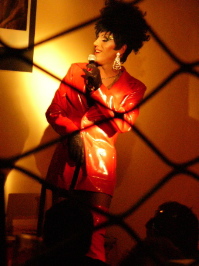 The most famous—or infamous—bar in Warsaw is Fantom, a busy place every night with its bar, sex-toy-video shop and luring back rooms into which patrons disappeared and remerged after some indulgence in anonymous sex. It’s patronized mostly by the leather/jeans crowd but we saw regular attire as well.
The most famous—or infamous—bar in Warsaw is Fantom, a busy place every night with its bar, sex-toy-video shop and luring back rooms into which patrons disappeared and remerged after some indulgence in anonymous sex. It’s patronized mostly by the leather/jeans crowd but we saw regular attire as well.
Just outside Fantom (which is hard to find unless you know exactly where it is behind anonymous doors) the Edwards showed us Miedzy Nami (Between Us) a lesbian-owned bar-café. To our delight the talented drag queen Lola Lou, swathed in bright red and strutting her stuff, sang in her own voice to the appreciative mixed audience. Lola’s web site is http://www.lolalou.com/
A Different View of Gay Warsaw
A different view of gay life in Warsaw and Poland was reported by Robert Biedron, the 28 year-old head of Campaign Against Homophobia (KPH), a LGB lobbying, advocacy and outreach organization. Without hesitation he said, “if you read the extensive study conducted in 2001 by Lambda Warsaw (a social support organization) it clearly states that 80% of Polish people disapprove of homosexuality. That should tell you something about this country and the high level of discrimination we face.”
Robert is a handsome man with boyish looks but the gray streaks in his hair betray his youth. Perhaps his gray comes from the daunting task he confronts as he faces down homophobia in government, industry, church and education. KPH tirelessly arranges educational seminars and presentations such as ‘I’m Gay. I’m Lesbian—Come Meet Me’. (One such seminar was cancelled last year at Krakow University after word got out what the event was about homosexuality. Protests and graffiti forced the cancellation of what was to be a quiet sit-down discussion between a handful of gays and any interested students or faculty.)
KPH also lobbies the government on behalf of the gay community to advocate for protective legislations (which are stated in the Polish constitution but ignored in reality) as well as registered partnerships.
Gay issues are a political football used to rally for or against political contenders and office holders. Few issues can guarantee publicity more than homosexuality in Poland and conservatives know how to work their supporters.
Unfortunately, Robert said, the current left of center leaders (Democratic Left Alliance) in parliament have done little to counteract the right. Even though some of these leaders attended the third anniversary party of KPH and spoke supportively of gays they did not take much action to support the gay community after the manipulated cancellation of the 2004 ‘Equality’ Parade by raucous opponents. Robert said this was likely due to the fragile thin majority the left government currently has; he thought it was likely they would lose their power in the next election and more rightist leadership would take over.
This is unfortunate and comes at a bad time for gay Poles. The 2001 Lambda Warsaw report revealed high levels of homophobia. The Pride parade was cancelled and a government minister, Izabela Jaruga-Nowacka, was physically assaulted recently after she proposed pro-gay legislation.
A Lack of Enthusiasm
Robert reflected that in the current political and social climate eagerness and enthusiasm among gays for activism seemed low. Why, I asked.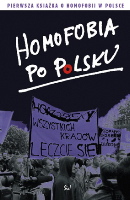
In Poland the urge to ‘catch up’ with the west in the decade following emancipation from communism was vital and exciting. Gay lib was fueled by the rainbow fire in the nearby west, in Berlin where gay and lesbian culture mushroomed since reunification to become the Amsterdam of Germany, perhaps surpassing it.
More slowly, clubs and bars began opening in Warsaw. Saunas and discos followed. But Poland was still an eastern European country, stunted by 45 years of communist economics and politics; despite being the most prosperous of the eastern economies personal prosperity was limited and free enterprise was more to difficult to incorporate. Having and keeping a job, often with low wages, was more important than professing one’s sexual orientation; few claims on behalf of gay rights were voiced aloud.
To be gay or lesbian in Poland was a tight secret, insulated from the conservatives in the government and the pulpits. Little was demanded and little was gained for gay rights. Organizations such as Lambda Warsaw, the city’s only significant LGB organzation, came along as late as 1997 like a single beacon in the night, but it was not highly visible.
Some gathering efforts coalesced enough to mount the first small gay pride parade in 2001 and bigger ones in 2002 and 2003 that elicited vocal and colorful but limited support. It also evoked growing opposition from conservative forces. In 2004 the religious right wing was organized and active enough to manipulate public opinion and the mayor against another parade and succeeded in getting it scrapped.
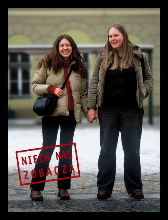
Anti-homophobia poster girls (KPH)
Today, Robert commented, fewer Warsaw lesbigay people seem motivated toward social and political activism. In addition to homophobia the proliferation of gay night life has distracted or satisfied many of the new generation of lesbigay youth. That and the Internet, which offers everything a socially and sexually active young person could want, from one-night stands to serious dating to virtual clubs and private parties to international organizations and local happenings. The web is safe and anonymous as well.
Sincere LGB organizing and community building seem to be a low priority for now. Serious relationships are not a prized goal. And Warsaw politics are unreliable for any near-future recognition of gay life or love, although the national senate debated the issue of registered partnerships in September 2004.
KPH and Lambda Warsaw
But gay Warsaw is not a complete activist vacuum by any means. Lambda Warsaw was founded in 1997 and focuses much of its activity on personal support such as coming out and finding resources and community assistance for LGB youth. “LW works for the benefit for homo- and bisexual people and their relatives, promotion of social tolerance towards homosexual orientation and for prevention of HIV/AIDS and other STIs.
Lambda Warsaw operates in the Warsaw region and bases its work on social activity of volunteers.” Their Rainbow Information and Assistance Center offers a telephone hotline, discussion groups, legal and psychological counseling, film club, religious expression group and a library.
Campaign Against Homophobia (KPH) came to life in 2001 “in order to protect the constitutionally guaranteed rights of sexual minorities”. KPH works consistently to fight back against intolerance and homophobia by engaging in political lobbying, educational seminars, petitions to legislative bodies and advocating on behalf of queer culture. KPH responds in words or actions to verbal or physical incidents of homophobia.
In conjunction with Lambda Warsaw KPH prepares an annual report on anti-gay discrimination in Poland. They continue to help coordinate the Pride Parade on May first; despite the cancellation of the 2004 event plans are being made for next year.
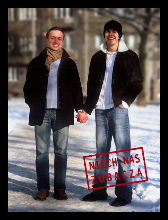
Anti-homophobia poster boys (KPH)
KPH mounted a controversial and well-publicized educational campaign in 2003 ‘Let Then See Us’ using huge billboards in Warsaw to show gays and lesbians as ‘normal’ people–until conservative opposition forced their removal after a week. The posters of the gay and lesbian couples can be seen in this story and on the campaign website.
KPH also has branches in Krakow, Silesia, Lodz, Wroclaw and Trojmiasto (tri-city: Gdansk, Gdynia and Sopot) in the north along the Baltic Sea.
One of their recent offerings (now finished) was an educational seminar called ‘I’m gay, I’m lesbian. Meets us’ which they offer to schools (for parents and students), colleges, businesses, police and military units as well as political associations, and on a rare occasion on TV. Presently KPH offers an educational project called ‘Laboratory of Tolerance’ that includes workshops for teachers, school counsellors, pscyhologists, students, police and activists from nongovermental organizations.
When asked if he has ever felt at risk for his own safety he said he occasionally receives anti-gay e-mail messages but does not feel in any danger. He has appeared on TV to press the cause for KPH. His boyfriend of several years, a government attorney, is not out but is very supportive of Robert’s advocacy work.
Reflecting on his mission, Robert said: ‘I think that homosexuals too easily deny their identity in Poland. Because they can ‘pass’ and participate in the culture they don’t feel gay rights are so important; they don’t’ feel the need to have these rights. Hiding is their way of gay life; there is little cross-country effort to change things.
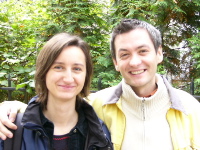
Robert Biedron (Pres.) and Marta Abramowicz (V.P.) of KPH
Robert Biedron (Pres.) and Marta Abramowicz (V.P.) of KPH
“There are protective rights described in the constitution but they are ignored for gays. It’s dangerous to be gay in some working class neighborhoods here. People get beat up and graffiti is sprayed on your door if they know you are gay.
“I think silence cerates a cage for homosexuals. Even if we are opposed we must speak up against homophobia. You know, they threw stones and yelled at us during our parade in Krakow this year. They said we should be in concentration camps.” He feels that the time is overdue for more activism and fighting back. “We (gays) can’t all come to Warsaw and have a community only here. It’s more liberal and open here but we must be present all over the country. I hope we can ‘stir the pot’, as you say. Brave words from a courageous rainbow warrior.
Appealing Krakow and a Quiet LGB Scene
Krakow’s beauty derives from its old town center packed with ornate churches, classic towers, venerable universities, theatres, art galleries and countless cafes surrounding the huge gothic market building in the square. It first appears like a Merchant-Ivory set for Masterpiece Theatre with cupolas, ornate facades, carved figures, fountains, church towers.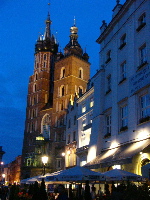
Outside this vibrant and colorful core Krakow appears as a bland residential and industrial megopolis of nearly 800,000 mostly Catholic citizens–meaning it’s also conservative and essentially homophobic.
Less than ten minutes walk from the heart of Krakow is the city’s only gay guest house, Friends, where I stayed. Anonymously tucked away at the end of a cul de sac and adjacent to Krakow’s main train line, Friends is actually two apartments divided into four rooms (one with a antique grand piano) in a five-story residential building. There are no signs on the outside, no indication of it’s presence to locals.
Friends is clean and colorfully painted. The rooms have ten foot ceilings which gives a spacious feel. However, the eight-foot windows look out toward Krakow’s main railroad line with its numerous commuter trains but I didn’t find this distracting. (The frequency decreases significantly after 9 PM.) The sounds reminded me slightly of the Kowalski walk-up flat in ‘Streetcar Named Desire’—a Polish coincidence?
Not unlike big city living, people tend to mind their own business behind closed doors so I came and went at Friends with hardly a notice from any other inhabitants of the building. (Friends also has a LGB guesthouses in Warsaw and Prague. They can be reached at http://warsaw.gayguide.net/
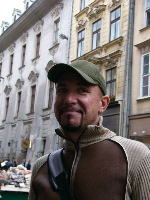 My host/owner was Przemek (‘pa-schem-ek’), (left) a friendly man in his thirties who is a musician by avocation but now a businessman with his guesthouse. He met me at the guesthouse and gave me a short orientation to ‘gay Krakow’, which didn’t take long since the scene here is limited.
My host/owner was Przemek (‘pa-schem-ek’), (left) a friendly man in his thirties who is a musician by avocation but now a businessman with his guesthouse. He met me at the guesthouse and gave me a short orientation to ‘gay Krakow’, which didn’t take long since the scene here is limited.
The next day Przemek accompanied me on a tour of Krakow’s enormous Wawel castle and we talked about gay life. Gay life here is sparse, discreet and scattered. There is no central LGBT organization or venue, no publication, no gay café or restaurant. There is less than a ‘community’ here and more of an enclave. “There is not even a cruising area now–it was busted by the police last year,” he lamented.
“Krakow is very Catholic and the Pope is from here so the gay situation is very little.”
I was aware that Krakow had a gay pride march and festival this year that drew about 3000 people. How could this happen if there are no gay or lesbian groups, I asked. Przemek said the event was mostly organized by Warsaw gay groups and it was very small and happened without many people knowing about it. What made Krakow’s festival ironic is that this city is more homophobic than Warsaw and yet the Warsaw festival was cancelled this year.
However, this gay ‘ghost town’ is redeemed by a small handful of clubs scattered around the thousand year-old city. Przemek directed me to the four gay venues–Kitsch, 7 Klub, ‘31’ and Queer. It was easy to see these in one evening as they are not far apart and easily accessed.
(In addition to these local places, Przemek sometimes drives across the border with friends to the Czech Republic city of Ostava where there is also a gay scene and is not as conservative and the prices are half what they are in Poland.)
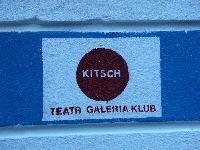 I went to Kitsch Klub about 9:30 PM on a Monday evening. Not surprising for that early hour there were only a dozen customers ranged around the four large rooms, including a big dance floor with its de rigeur glitter ball hung high in the black-walled chamber. Kitsch bills itself as a ‘teatr-galerie-klub’ but it’s clearly a gay dance bar patronized by 70% gays and 30% non-gays who come for the music and the easy ambience. Some straight women come with their woman friends for an easy night out without being hustled by guys on the make.
I went to Kitsch Klub about 9:30 PM on a Monday evening. Not surprising for that early hour there were only a dozen customers ranged around the four large rooms, including a big dance floor with its de rigeur glitter ball hung high in the black-walled chamber. Kitsch bills itself as a ‘teatr-galerie-klub’ but it’s clearly a gay dance bar patronized by 70% gays and 30% non-gays who come for the music and the easy ambience. Some straight women come with their woman friends for an easy night out without being hustled by guys on the make.
Unfortunately the owner did not speak English so I turned to other staff, such as Gregor the attractive bartender, who happily briefed me between mixing drinks that Kitsch stays open until 4 AM and that there has never been any problem with police or authorities since they opened. Indeed Kitsch could hardly be intrusive or conspicuous since it’s on the third walk-up floor of a big office block building. To get in you have to ring a doorbell next to a plain metal door with two peep holes that let the door staff see who’s wanting in.
There’s no cover charge; people don’t have a lot of money in this country. Although Poland has been in the forefront of an eastern bloc of ambitious European countries struggling to catch up with the west there is still very high unemployment rate and salaries often don’t exceed US$300 a month. Precious little 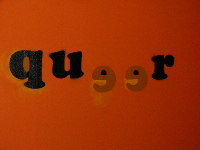 disposable cash is in the pockets of young gays and lesbians. But it’s more than ten years ago and more than before that. Discount clothing stores and mid-scale boutique chains like Benetton line the downtown along with budget and elegant restaurants, cafes, lots of florists, quality hotels and inexpensive ice cream shops.
disposable cash is in the pockets of young gays and lesbians. But it’s more than ten years ago and more than before that. Discount clothing stores and mid-scale boutique chains like Benetton line the downtown along with budget and elegant restaurants, cafes, lots of florists, quality hotels and inexpensive ice cream shops.
Queer is the smallest of the four gay clubs with a diminutive bar room and a small lounge minimally decorated with a single painting of a nude male. I doubt that thirty people could squeeze into these rooms but the bar staff were friendly, unhurried and visually appealing.
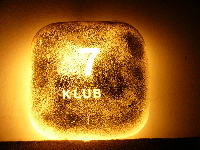 7Klub is bigger with a dance floor, 2 lounges–one of which is non-smoking and looks like grandma’s living room with sofas, carpets and lanterns on the brick walls under a vaulted ceiling. It sports a number of theme nights including drag night occasionally. It’s hung with a few paintings and sculptures including quirky silver-colored life-size nude male reliefs on the ceiling. 7Klub has been open for two years with no reactions from the local residents or authorities.
7Klub is bigger with a dance floor, 2 lounges–one of which is non-smoking and looks like grandma’s living room with sofas, carpets and lanterns on the brick walls under a vaulted ceiling. It sports a number of theme nights including drag night occasionally. It’s hung with a few paintings and sculptures including quirky silver-colored life-size nude male reliefs on the ceiling. 7Klub has been open for two years with no reactions from the local residents or authorities.
For the erotic night crawler looking for carnal contact, Club Ciemni is the place. It’s not easy to find as the unmarked entry is through a arched hallway and a plain steel door with the number 31 faintly stenciled on. Then down a few step through a buzzer door and into the cellar location. This is very different from any other venue in Krakow; it’s essentially a set of dark rooms with the bar almost as an afterthought. Around one corner is a lounge area with a monitor screening hard-core flicks. Cruising guys (fully clothed) wander among the several spaces, private cubicles and a small dark maze. To add a S&M touch the back rooms are separated from the bar area by metal cage ‘walls’.
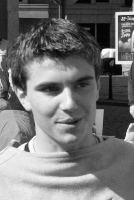 No picture of Club Ciemni so this will have to do! (Last seen in Krakow center.)
No picture of Club Ciemni so this will have to do! (Last seen in Krakow center.)
As usual in these places the darker the lighting the fewer words. If you want to talk, the bar area is lighter and more chatty. I spoke with handsome Hassem, the bartender from Beruit who is studying classical music at Krakow University. He cheerfully told me, in perfect English, about the procedures and activities of Ciemni. It’s only been open since late 2003 and is quite popular between eleven and midnight on weeknights and later on weekends when things don’t thin out until after three AM. Hassem said there has not been any problems with outsiders; the place is listed as a bar but it’s doubtful the folks at city hall have a clue as to the favorite aperitif that’s here.
That was it for the gay scene in Krakow: discreet, subdued and nominal. But there did not seem to be a demand here for more. Most of the people in this ancient city (which fortunately was not bombed during WW2) were busy with the rest of their lives—families, lovers, work or university studies.
There are plenty of other unique sights for the Krakow visitor to see such as the world class Czartoryski Museum, the first historical museum in Poland with it’s major prize, Leonardo da Vinci’s ‘Lady with the Ermine’ that retracts into wall safe each night. Aside from Krakow’s strong appeal to tourists it’s home to one of Poland’s most esteemed universities which is partly housed in great ancient buildings such as the Collegium Maius dating from the 15th century.
In the last issue of Queer City, there were also a few LGB listings in other major cities in Poland—Lodz, Poznan, Wroclaw and Szczecin.
Other Sites and Missing Memorials
My journey also lightly crossed paths with some of Poland’s great musicians. Frederic Chopin (1810-49) was born near Warsaw but moved to Paris at the age of 19 where he lived only another 19 years. Reports are that he was not straight and not gay; he was mostly into his moods and music. In Warsaw there is a palatial Chopin Museum with one of Chopin’s actual pianos and some original music scores. South of Poznan I stopped in the village of Antonin where Chopin stayed in the country home of the wealthy Radziwill family. Today this unusual octagonal wooden ‘Hunting Palace’ is a hotel and hosts an annual Chopin festival.
Further south in the southern Tatra mountains is the resort town 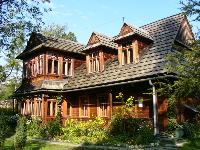 of Zapokane where one of Poland’s most illustrious gay classical music composers Karol Szymanowski (1882-1937) lived. His beautiful wooden house (left) stands now as a museum in his honor. He is revered as the father of contemporary Polish classical music. A rich, talented and handsome aristocrat he was a key figure in the social swirl of pre WW1 Berlin and Vienna.
of Zapokane where one of Poland’s most illustrious gay classical music composers Karol Szymanowski (1882-1937) lived. His beautiful wooden house (left) stands now as a museum in his honor. He is revered as the father of contemporary Polish classical music. A rich, talented and handsome aristocrat he was a key figure in the social swirl of pre WW1 Berlin and Vienna.
Along with other famous gay artists like photographer Baron von Gloeden, Oscar Wilde and Andre Gide, Szymanowski found the relaxed male sexuality of Sicily, Morocco and Tunisia to be psychologically liberating and inspiring for his music. His paramour for a while was a 15-year-old Russian boy/man who broke his heart when the youth became the lover of ballet master Sergei Diaghilev. His life mingled with other world-class artists such as pianist Artur Rubinstein and pianist Ignacy Paderewski (Poland’s Prime Minister after WW1). Unfortunately, anti-gay intrigues in 1932 later forced Szymanowski out of the directorship of the Warsaw Academy of Music. Nevertheless his legacy of great music long survives him (and the anonymous homophobes); his works are still performed by orchestras around the world.
Speaking of memorials, I visited three harrowing concentration camp locations during my visit: Auschwitz, Birkenau and Treblinka. At the Auschwitz site several of the former barracks that housed prisoners have been turned into museums for various countries ravaged by the Nazis. One of them is a fitting museum that gives tribute to the Roma (Gypsies) who were killed along with Jews, Catholics, Poles, intellectuals and political resistors.
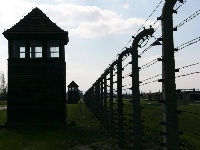 But a glaring omission at this daunting killing ground, I noticed, was any obvious remembrance, museum or memorial to the thousands of homosexuals put to death by the psychotic Germans.
But a glaring omission at this daunting killing ground, I noticed, was any obvious remembrance, museum or memorial to the thousands of homosexuals put to death by the psychotic Germans.
(Note: Subsequent to my visit, I received a message from Marta Abramowicz, vice president of KPH stating: “I was in Birkenau 2 years ago and I saw every victim group including pink triangle (gays) and black triangle (feminists, lesbians) described on special guide table. In a museum I saw the uniforms of prisoners and one of three of these uniforms had a pink triangle. By the way, Robert Biedron is the author of the first master thesis in Poland about gay holocaust. When we were in Birkenau as KPH the authorities of the museum were very interested in cooperation with us to fill out the blank in our history there.”)
So, gay Poland is a mixed bag. Cultural homophobia is high and religious discrimination is strong but gay youth are finding more music to dance to, more friendly clubs to attend, more Internet outlets and a determined core of activists pushing for gay rights at the national level. Poland’s recent admission to the European Union will have a significant economic impact, for better or worse, over the next ten years. But the price of admission to the club of Europe also requires that anti-gay discrimination be addressed and legislated against in no uncertain terms. The European Court of Justice is not so far away in Holland.
Postscript: When I fist met Robert Biedron he was practicing his family values by baby-sitting for his partner’s sister (sister-in-law someday hopefully). Here he is with the nephew while on the phone doing KPH business.
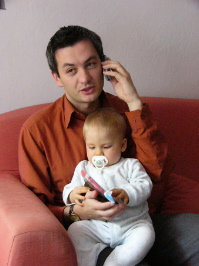
Also see:
Gay Poland Stories
Gay Poland News & Reports 2001 to present
Gay Poland Photo Galleries

